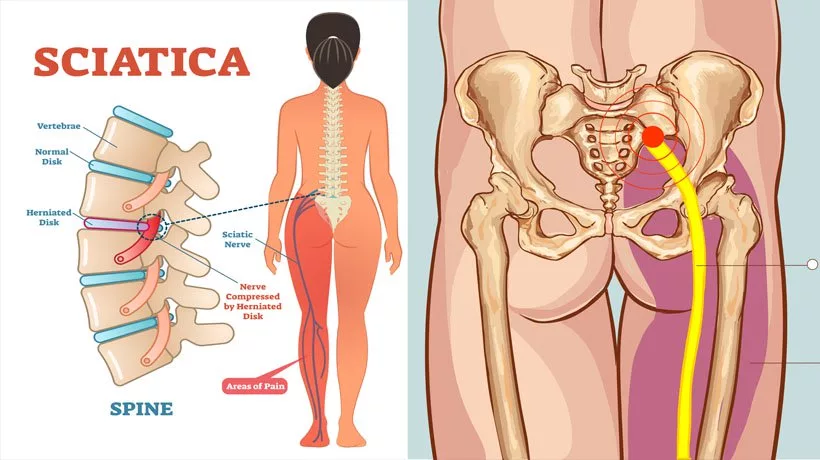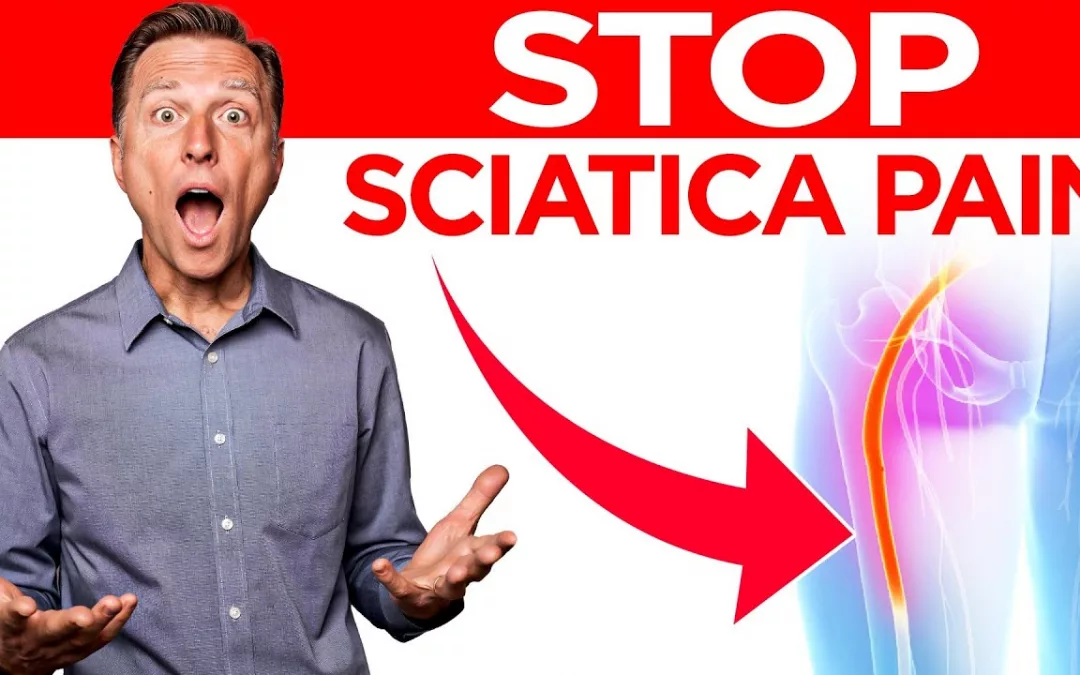Unveiling the Secrets: The Ultimate Plan to End Sciatica Pain
Sciatica pain, characterized by radiating discomfort along the path of the sciatic nerve, is a common and often debilitating condition that affects millions of people worldwide. The good news is that there are various strategies, treatments, and lifestyle changes that can help you bid farewell to sciatica pain and regain control over your life. In this blog post, we will delve into the causes, symptoms, and effective ways to alleviate and prevent sciatica pain, allowing you to embark on a journey towards a pain-free existence.
Understanding Sciatica Pain

The sciatic nerve, the longest nerve in the human body, originates in the lower back and extends down each leg. Sciatica occurs when this nerve is compressed or irritated, leading to a range of symptoms that can include sharp or burning pain, numbness, and tingling. Understanding the root causes of sciatica is crucial for developing effective strategies for relief.
Common Causes of Sciatica Pain

Sciatica pain is often a result of compression or irritation of the sciatic nerve, which is the longest nerve in the human body. The sciatic nerve runs from the lower back, through the buttocks, and down each leg. Various conditions and factors can contribute to sciatica pain. Here are some common causes:
1. Herniated Disc
- Description: The soft inner material of a disc between vertebrae leaks out, irritating or compressing the nearby sciatic nerve.
- Symptoms: Sharp, shooting pain that radiates down the leg, numbness, tingling.
2. Spinal Stenosis
- Description: The narrowing of the spinal canal, often due to aging, can put pressure on the sciatic nerve.
- Symptoms: Pain, tingling, or weakness that may worsen with walking or standing.
3. Piriformis Syndrome
- Description: The sciatic nerve is compressed or irritated by the piriformis muscle in the buttocks.
- Symptoms: Pain in the buttocks that may radiate down the leg, aggravated by sitting.
4. Degenerative Disc Disease
- Description: The discs between vertebrae degenerate over time, affecting the spine’s stability and potentially irritating the sciatic nerve.
- Symptoms: Pain, stiffness, reduced flexibility.
5. Spondylolisthesis
- Description: One vertebra slips forward over another, causing pressure on the nerves, including the sciatic nerve.
- Symptoms: Lower back pain, sciatica, muscle tightness.
6. Trauma or Injury
- Description: Accidents, falls, or injuries can lead to sciatica pain by causing damage to the spine or surrounding tissues.
- Symptoms: Immediate or delayed onset of pain, depending on the severity of the injury.
7. Spinal Tumors
- Description: Abnormal growths in or around the spine can compress the sciatic nerve.
- Symptoms: Progressive pain, neurological symptoms, weakness.
8. Pregnancy
- Description: The weight of the growing uterus may compress the sciatic nerve in some pregnant women.
- Symptoms: Pain, tingling, or numbness in the buttocks or legs.
9. Infections
- Description: Infections affecting the spine or surrounding tissues can lead to sciatica pain.
- Symptoms: Pain, fever, localized tenderness.
10. Bone Spurs
- Description: Overgrowth of bone, often due to osteoarthritis, can narrow the space around the nerve.
- Symptoms: Pain, reduced range of motion.
11. Lumbar Spinal Stenosis
- Description: Narrowing of the spinal canal in the lower back can put pressure on the sciatic nerve roots.
- Symptoms: Pain, tingling, or weakness in the legs, particularly during walking.
12. Obesity
- Description: Excess body weight can contribute to sciatica by putting additional pressure on the spine.
- Symptoms: Increased risk of developing sciatica, exacerbation of symptoms.
13. Sacroiliitis
- Description: Inflammation of the sacroiliac joint can irritate the nearby sciatic nerve.
- Symptoms: Pain in the lower back and buttocks, radiating down the leg.
14. Psychological Factors
- Description: Emotional stress and psychological conditions may contribute to the perception and intensity of sciatica pain.
- Symptoms: Heightened pain perception, exacerbation of symptoms during periods of stress.
It’s important to note that sciatica is a symptom rather than a diagnosis, and the underlying cause can vary from person to person. A thorough medical evaluation is crucial for accurate diagnosis and the development of an appropriate treatment plan tailored to the specific cause of sciatica pain. If you are experiencing persistent or severe sciatica symptoms, consult with a healthcare professional for proper assessment and guidance.
Saying Goodbye to Sciatica Pain: Strategies for Relief

Suffering from sciatica pain can be a challenging experience, but the good news is that there are various effective strategies for relief. Whether you’re dealing with acute discomfort or chronic sciatica, implementing these strategies can help you say goodbye to sciatica pain and reclaim control over your life.
1. Hot and Cold Therapy
- Heat Application: Applying a heat pack to the affected area can help relax muscles and alleviate pain.
- Cold Application: Ice packs can reduce inflammation and numb the affected area, providing relief.
2. Over-the-Counter Medications
- Nonsteroidal Anti-Inflammatory Drugs (NSAIDs): Medications like ibuprofen can help reduce pain and inflammation.
- Pain Relievers: Acetaminophen may be recommended for pain management.
3. Prescription Medications
- Muscle Relaxants: These medications can help relax muscles and alleviate pain.
- Nerve Pain Medications: Prescription drugs targeting nerve pain may be prescribed for severe sciatica.
4. Physical Therapy
- Strengthening Exercises: Physical therapists can design exercises to strengthen core muscles, supporting the spine.
- Stretching Routines: Targeted stretches can improve flexibility and alleviate pressure on the sciatic nerve.
5. Epidural Steroid Injections
- Description: In severe cases, injections of corticosteroids into the epidural space can reduce inflammation and provide long-lasting relief.
6. Chiropractic Care
- Spinal Adjustments: Chiropractors can perform adjustments to realign the spine and relieve pressure on the sciatic nerve.
7. Acupuncture
- Description: Traditional Chinese medicine involves inserting thin needles into specific points to stimulate energy flow and relieve pain.
8. Mind-Body Techniques
- Yoga: Gentle yoga poses can improve flexibility and reduce sciatica symptoms.
- Meditation: Mindfulness meditation can help manage pain perception and reduce stress.
9. Massage Therapy
- Deep Tissue Massage: Massage can alleviate muscle tension and improve circulation, promoting healing.
10. Lifestyle Modifications
- Ergonomic Adjustments: Maintain proper posture and make ergonomic changes to your workspace to reduce strain on the spine.
- Weight Management: Maintain a healthy weight to alleviate pressure on the spine and nerves.
Prevention Strategies: Keeping Sciatica at Bay

Preventing the recurrence of sciatica involves adopting proactive measures and making lifestyle choices that support the health of your spine. By incorporating the following prevention strategies into your daily routine, you can reduce the risk of experiencing sciatica and enjoy a more resilient and pain-free back.
1. Regular Exercise
- Description: Engage in activities that promote overall fitness, with a focus on core-strengthening exercises.
- Benefits: Regular exercise improves flexibility, reduces inflammation, and supports spinal health.
2. Healthy Posture Habits
- Description: Be conscious of your posture during daily activities.
- Benefits: Good posture reduces strain on the spine and minimizes the risk of sciatica.
3. Proper Lifting Techniques
- Description: Lift heavy objects by bending your knees, keeping the object close to your body.
- Benefits: Proper lifting techniques prevent strain on the lower back and reduce the risk of disc herniation.
4. Stretching and Flexibility Exercises
- Description: Incorporate regular stretching into your routine, targeting muscles that support the spine.
- Benefits: Stretching improves flexibility, reduces muscle tension, and supports overall spinal health.
5. Maintain a Healthy Weight
- Description: Adopt a balanced diet and engage in regular physical activity to achieve and maintain a healthy weight.
- Benefits: Weight management reduces stress on the spine, preventing excess pressure on the sciatic nerve.
6. Stay Hydrated
- Description: Adequate water intake supports the health of spinal discs.
- Benefits: Hydration ensures the discs remain well-hydrated, promoting flexibility and shock absorption.
7. Quit Smoking
- Description: Smoking can contribute to disc degeneration and hinder the body’s ability to heal.
- Benefits: Quitting smoking supports overall spinal health and reduces the risk of sciatica.
8. Mindfulness and Stress Management
- Description: Incorporate stress-reducing techniques into your routine, such as meditation or deep breathing exercises.
- Benefits: Managing stress reduces muscle tension and contributes to pain prevention.
9. Quality Sleep
- Description: Ensure you get enough restorative sleep each night.
- Benefits: Quality sleep supports the body’s healing processes and contributes to overall well-being.
10. Regular Check-ups
- Description: Schedule regular check-ups with healthcare professionals to address any emerging issues promptly.
- Benefits: Early intervention can prevent the progression of conditions that may lead to sciatica.
Conclusion: Embracing a Pain-Free Future

Saying goodbye to sciatica pain involves a holistic approach that combines various strategies for relief and prevention. Whether you’re exploring therapeutic interventions, making lifestyle modifications, or incorporating preventive measures into your daily routine, the goal is to support the health of your spine and minimize the risk of sciatica recurrence. By taking proactive steps, you can embark on a journey towards a pain-free future, reclaiming control over your physical well-being and enjoying life to the fullest. Remember, individual responses to treatments may vary, and consulting with healthcare professionals for personalized advice is always recommended for effective and tailored care.
CALL NOW +1-407-434-7246
If you have suffered any type of injury or have been experiencing pain that just won’t go away regardless of what you do, then all you have to do is call and speak with our friendly staff. Find Best Sciatica Chiropractor in Orlando, Florida. Our team can help you get the treatment you need and ensure that the pain you experience is alleviated – once and for all.
We are proud to serve the areas of Orlando, Altamonte Springs, Haines City, Plant City, Kissimmee, Winter Haven, and Ocala.
Contact us for Chiropractor near me in Orlando, Florida for an Appointment Today.
How do you relieve sciatica pain in bed?
It's more comfortable to lie on the pain-free side with the sciatic side on the top. The knees should be bent with a pillow placed between them to support the spine and pelvis. If there is a gap between the waist and the mattress, place a small pillow there. A pillow may be needed for arm support as well.
Is walking good for sciatica?
Medical professionals generally advise people to resume physical activities, including walking, as soon as possible. Walking may help reduce pain, inflammation, and disability in people with sciatica. A doctor may refer a person to a physical therapist for support and guidance on exercising with sciatica.
Will sciatica go away?
Can sciatica just go away? The answer is yes - most cases resolve within six weeks from the onset of symptoms.
How long does sciatica last?
People can experience sciatic pain in the lower back, buttocks, and down the back of either leg. Sciatica usually gets better in 4–6 weeks, but it could last longer. If the pain is severe or lasts more than 6 weeks, consider talking to a doctor about treatment options.
Which leg does sciatica affect?
Sciatica occurs when there is pressure on or damage to the sciatic nerve. This nerve starts in the lower back and runs down the back of each leg. This nerve controls the muscles of the back of the knee and lower leg.



